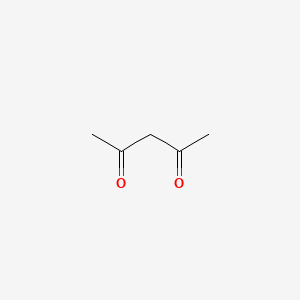| MeSH term | MeSH ID | Detail |
|---|---|---|
| Adenocarcinoma | D000230 | 166 associated lipids |
| Dermatitis, Contact | D003877 | 59 associated lipids |
| Body Weight | D001835 | 333 associated lipids |
| Edema | D004487 | 152 associated lipids |
| Purpura, Thrombocytopenic | D011696 | 2 associated lipids |
| Glioma | D005910 | 112 associated lipids |
| Nervous System Diseases | D009422 | 37 associated lipids |
| Seizures | D012640 | 87 associated lipids |
| Fetal Resorption | D005327 | 15 associated lipids |
| Carcinoma, Lewis Lung | D018827 | 22 associated lipids |
2,4-pentanedione
2,4-pentanedione is a lipid of Fatty Acyls (FA) class. The related lipids are Butyrates.
Cross Reference
Introduction
To understand associated biological information of 2,4-pentanedione, we collected biological information of abnormalities, associated pathways, cellular/molecular locations, biological functions, related genes/proteins, lipids and common seen animal/experimental models with organized paragraphs from literatures.
What diseases are associated with 2,4-pentanedione?
There are no associated biomedical information in the current reference collection.
Possible diseases from mapped MeSH terms on references
We collected disease MeSH terms mapped to the references associated with 2,4-pentanedione
PubChem Associated disorders and diseases
What pathways are associated with 2,4-pentanedione
There are no associated biomedical information in the current reference collection.
PubChem Biomolecular Interactions and Pathways
Link to PubChem Biomolecular Interactions and PathwaysWhat cellular locations are associated with 2,4-pentanedione?
There are no associated biomedical information in the current reference collection.
What functions are associated with 2,4-pentanedione?
There are no associated biomedical information in the current reference collection.
What lipids are associated with 2,4-pentanedione?
Related references are published most in these journals:
| Lipid concept | Cross reference | Weighted score | Related literatures |
|---|
What genes are associated with 2,4-pentanedione?
There are no associated biomedical information in the current reference collection.
What common seen animal models are associated with 2,4-pentanedione?
There are no associated biomedical information in the current reference collection.
NCBI Entrez Crosslinks
All references with 2,4-pentanedione
Download all related citations| Authors | Title | Published | Journal | PubMed Link |
|---|---|---|---|---|
| Sinn H and Silvester DJ | Simplified cell labelling with indium-111 acetylacetone. | 1979 | Br J Radiol | pmid:497640 |
| Stephens BG et al. | Propylene carbonate extraction of tris(pentan-2,4-dione)-iron(3) from aqueous solution: application to the spectrophotometric determination of iron. | 1971 | Analyst | pmid:5135210 |
| Degen PH | Determination of unchanged hydralazine in plasma by gas-liquid chromatography using nitrogen-specific detection. | 1979 | J. Chromatogr. | pmid:546921 |
| Sugiura M et al. | A simple colorimetric method for determination of serum triglycerides with lipoprotein lipase and glycerol dehydrogenase. | 1977 | Clin. Chim. Acta | pmid:589792 |
| El-Saleh SC et al. | Modification of Lys-237 on actin by 2,4-pentanedione. Alteration of the interaction of actin with tropomyosin. | 1984 | J. Biol. Chem. | pmid:6147349 |
| Schauwecker DS et al. | Evaluation of complicating osteomyelitis with Tc-99m MDP, In-111 granulocytes, and Ga-67 citrate. | 1984 | J. Nucl. Med. | pmid:6235327 |
| Yost DA and Anderson BM | Studies of Bungarus fasciatus venom NAD glycohydrolase. Inhibition, modification, and transglycosidation reactions. | 1982 | J. Biol. Chem. | pmid:6274863 |
| Gallop PM et al. | Chemical quantitation of hemoglobin glycosylation: fluorometric detection of formaldehyde released upon periodate oxidation of glycoglobin. | 1981 | Anal. Biochem. | pmid:6275744 |
| Breuer E et al. | Antiviral compounds. 1. Structure-activity relationship of some antiviral enediones derived from aldehydo sugars. | 1983 | J. Med. Chem. | pmid:6298419 |
| Wallace CJ and Rose K | The semisynthesis of analogues of cytochrome c. Modifications of arginine residues 38 and 91. | 1983 | Biochem. J. | pmid:6318729 |
